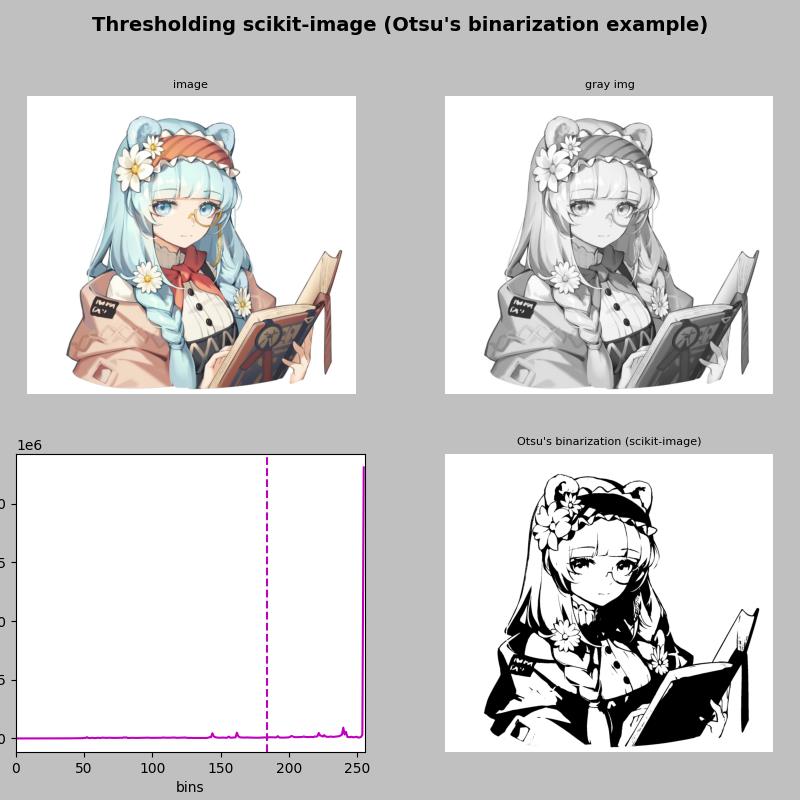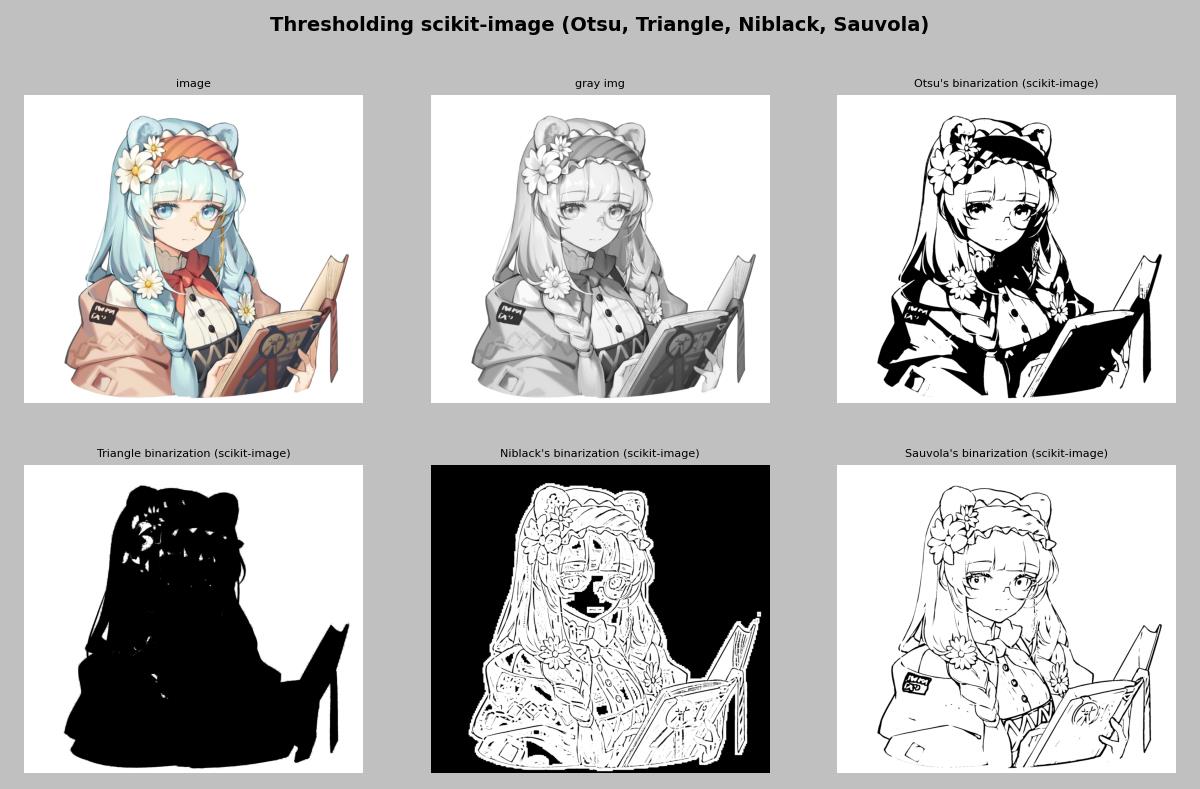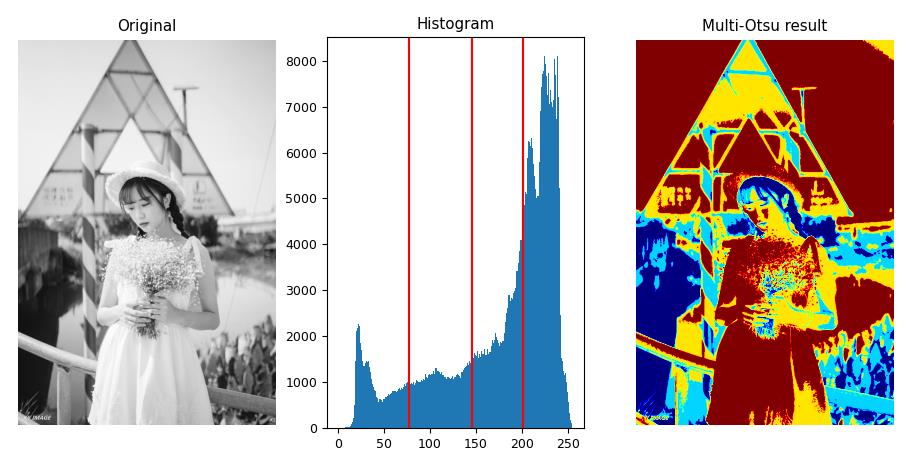scikit-image 中用于图像分割的阈值算法
Posted 盼小辉丶
tags:
篇首语:本文由小常识网(cha138.com)小编为大家整理,主要介绍了scikit-image 中用于图像分割的阈值算法相关的知识,希望对你有一定的参考价值。
scikit-image 简介与安装
我们已经在《OpenCV-Python实战(9)——OpenCV用于图像分割的阈值技术》中介绍了图像阈值技术,由于图像阈值技术是许多计算机视觉应用中的关键步骤,因此许多算法库中都包含阈值技术,其中就包括 scikit-image。 scikit-image 是用于图像处理的算法包,其详细介绍可以参考官方网站,由 scikit-image 操作的图像需要先转换为 NumPy 数组。
在本文中,我们将利用 scikit-image 实现阈值技术。如果还没有安装 scikit-image 库,首先需要使用以下命令安装 scikit-image:
pip install scikit-image
使用 scikit-image 进行阈值处理
为了在 scikit-image 中使用阈值算法,我们以 Otsu 的二值化算法对测试图像进行阈值处理为例进行介绍。第一步是导入所需的包:
from skimage.filters import threshold_otsu
from skimage import img_as_ubyte
然后使用 scikit-image 应用 Otsu 的二值化算法:
# 加载图像
image = cv2.imread('example.png')
gray_image = cv2.cvtColor(image, cv2.COLOR_BGR2GRAY)
hist = cv2.calcHist([gray_image], [0], None, [256], [0, 256])
# 基于 otsu 方法的返回阈值
thresh = threshold_otsu(gray_image)
# 生成布尔数组:
binary = gray_image > thresh
# 转换为uint8数据类型
binary = img_as_ubyte(binary)
# 可视化
def show_img_with_matplotlib(color_img, title, pos):
img_RGB = color_img[:, :, ::-1]
ax = plt.subplot(2, 2, pos)
plt.imshow(img_RGB)
plt.title(title, fontsize=8)
plt.axis('off')
def show_hist_with_matplotlib_gray(hist, title, pos, color, t=-1):
ax = plt.subplot(2, 2, pos)
plt.xlabel("bins")
plt.ylabel("number of pixels")
plt.xlim([0, 256])
plt.axvline(x=t, color='m', linestyle='--')
plt.plot(hist, color=color)
show_img_with_matplotlib(image, "image", 1)
show_img_with_matplotlib(cv2.cvtColor(gray_image, cv2.COLOR_GRAY2BGR), "gray img", 2)
show_hist_with_matplotlib_gray(hist, "grayscale histogram", 3, 'm', thresh)
show_img_with_matplotlib(cv2.cvtColor(binary, cv2.COLOR_GRAY2BGR), "Otsu's binarization (scikit-image)", 4)
plt.show()
threshold_otsu(gray_image) 函数根据 Otsu 的二值化算法返回阈值。之后,使用此值构建二进制图像( dtype= bool ),最后应将其转换为 8 位无符号整数格式( dtype=uint8 )以进行可视化,使用img_as_ubyte() 函数完成转换过程。
程序输出如下图所示:

接下来,介绍下如何使用 scikit-image 中的一些其它阈值技术。
scikit-image 中的其他阈值技术
接下来,将对比 Otsu、triangle、Niblack 和 Sauvola 阈值技术进行阈值处理的不同效果。 Otsu 和 triangle 是全局阈值技术,而 Niblack 和 Sauvola 是局部阈值技术。当背景不均匀时,局部阈值技术则是更好的方法阈值处理方法。
同样的,第一步是导入所需的包:
from skimage.filters import threshold_otsu, threshold_triangle, threshold_niblack, threshold_sauvola
from skimage import img_as_ubyte
import cv2
import matplotlib.pyplot as plt
调用每个阈值方法( threshold_otsu()、threshold_niblack()、threshold_sauvola() 和 threshold_triangle() ),以使用 scikit-image 对比执行阈值操作:
# Otsu
thresh_otsu = threshold_otsu(gray_image)
binary_otsu = gray_image > thresh_otsu
binary_otsu = img_as_ubyte(binary_otsu)
# Niblack
thresh_niblack = threshold_niblack(gray_image, window_size=25, k=0.8)
binary_niblack = gray_image > thresh_niblack
binary_niblack = img_as_ubyte(binary_niblack)
# Sauvola
thresh_sauvola = threshold_sauvola(gray_image, window_size=25)
binary_sauvola = gray_image > thresh_sauvola
binary_sauvola = img_as_ubyte(binary_sauvola)
# triangle
thresh_triangle = threshold_triangle(gray_image)
binary_triangle = gray_image > thresh_triangle
binary_triangle = img_as_ubyte(binary_triangle)
输出可以在下一个屏幕截图中看到:
 如上图所示,当图像不均匀时,局部阈值方法可以提供更好的结果。因此,可以将这些局部阈值方法应用于文本识别。
如上图所示,当图像不均匀时,局部阈值方法可以提供更好的结果。因此,可以将这些局部阈值方法应用于文本识别。
最后,我们了解一个更加有趣的阈值算法—— Multi-Otsu 阈值技术,其可用于将输入图像的像素分为多个不同的类别,每个类别根据图像内灰度的强度计算获得。
Multi-Otsu 根据所需类别的数量计算多个阈值,默认类数为3,此时将获得三个类别,算法返回两个阈值,由直方图中的红线表示。
import matplotlib
import numpy as np
import cv2
from skimage import data
from skimage.filters import threshold_multiotsu
image = cv2.imread('8.png')
image = cv2.cvtColor(image, cv2.COLOR_BGR2GRAY)
# 使用默认值调用 threshold_multiotsu()
thresholds = threshold_multiotsu(image)
regions = np.digitize(image, bins=thresholds)
def show_img_with_matplotlib(img, title, pos, cmap):
ax = plt.subplot(1, 3, pos)
plt.imshow(img, cmap=cmap)
plt.title(title, fontsize=8)
plt.axis('off')
fig, ax = plt.subplots(nrows=1, ncols=3, figsize=(10, 3.5))
# 绘制灰度图像
show_img_with_matplotlib(image, 'Original', 1, cmap='gray')
# 可视化直方图
ax[1].hist(image.ravel(), bins=255)
ax[1].set_title('Histogram')
for thresh in thresholds:
ax[1].axvline(thresh, color='r')
# 可视化 Multi Otsu 结果
show_img_with_matplotlib(regions, 'Multi-Otsu result', 3, cmap='jet')
plt.subplots_adjust()
plt.show()

可以通过修改 threshold_multiotsu 的 classes 参数来改变类别数,以观察不同效果:
# 将类别数修改为4
thresholds = threshold_multiotsu(image, classes=3)
regions = np.digitize(image, bins=thresholds)

scikit-image 也提供了其他更多的阈值技术,可以参阅 API 文档,以查看所有可用方法。
小结
本文中,我们介绍了如何使用 scikit-image 中的不同阈值算法,包括两种全局阈值技术( Otsu 和 三角形二值算法)和两种局部阈值技术( Niblack 和 Sauvola 算法)。
相关链接
以上是关于scikit-image 中用于图像分割的阈值算法的主要内容,如果未能解决你的问题,请参考以下文章